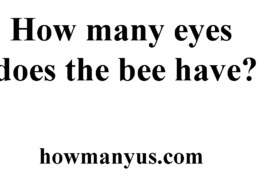How many eyes does the bee have?
The question “How many eyes does the bee have?” delves into the fascinating anatomy of bees, specifically focusing on their visual capabilities. Bees, like many insects, possess compound eyes, which are different from the single-lens eyes of humans and other vertebrates. Understanding the structure and function of bee eyes provides insights into their behavior, navigation, and adaptation to their environment.
Bees are known for their complex eyesight, which plays a crucial role in their survival and behavior. The compound eyes of bees are composed of numerous tiny hexagonal units called ommatidia, each containing photoreceptor cells. This unique eye structure allows bees to perceive a wide range of colors, detect polarized light, and navigate efficiently in their surroundings.
How many eyes does the bee have?
Significance of the Question:
- Visual Perception: Exploring bee eyes helps us understand how these insects perceive the world visually and interact with their environment.
- Behavioral Adaptations: Bee eyesight influences their foraging behavior, communication within the hive, and ability to navigate complex landscapes.
- Pollination: Bees rely on their visual acuity to identify flowers, locate nectar sources, and carry out essential pollination activities.
- Evolutionary Adaptations: The structure of bee eyes reflects their evolutionary adaptation to specific ecological niches and foraging strategies.
Understanding the number and arrangement of bee eyes provides valuable insights into the sensory ecology of these vital pollinators and contributes to broader discussions on insect behavior and evolution.


Bees have a fascinating visual system adapted to their ecological needs. Let’s explore the anatomy and function of bee eyes to address the question “How many eyes does the bee have?” comprehensively while optimizing for SEO.
Anatomy of Bee Eyes:
Bees possess two types of eyes:
Number of Ommatidia:
The number of ommatidia in a bee’s compound eyes varies depending on the species and age of the bee. Honeybees, for example, can have anywhere from 5,000 to 8,000 ommatidia per eye. Each ommatidium contributes to the bee’s overall visual perception, allowing them to detect motion, recognize patterns, and navigate complex environments.
Visual Acuity and Adaptations:
Bees are sensitive to ultraviolet light and can perceive colors in the UV spectrum, which is invisible to humans. This adaptation is crucial for flower recognition and efficient foraging. Bee eyes are also well-suited for motion detection, allowing them to quickly respond to potential threats or food sources.
Behavioral Implications:
The remarkable visual capabilities of bees play a critical role in:
Conclusion:
In summary, bees possess complex visual systems adapted to their ecological roles as pollinators and social insects. Their compound eyes, composed of thousands of ommatidia, enable them to perceive a diverse range of visual information essential for survival and reproductive success.